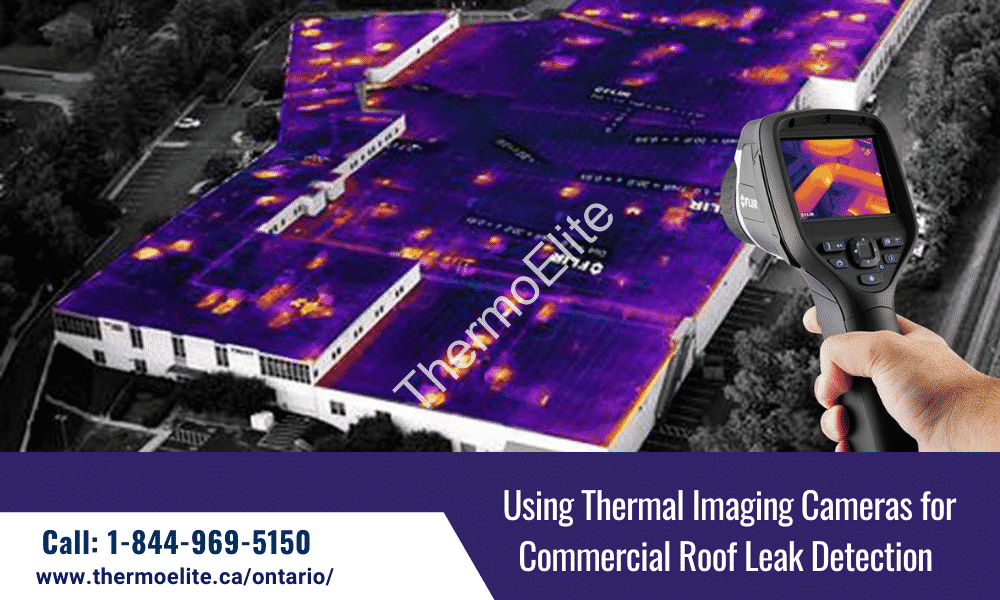With a thermal imaging camera, you can create a detailed map of low-slope commercial roofs, which tell you where excess moisture has been trapped. It reveals where the leakage source may be, or where the insulation is damaged. A roofing professional may take an aerial image of the entire roof, or choose to take images and then compile a complex map to show areas of leakage in separate colors. With the thermal images, the search for water intrusion is narrowed down without causing any damage to the roof or puncturing it. This helps save time while locating exactly where repairs are needed.
Moisture from a leakage causes a thermal mass to add to a certain area of the roofing material. Due to this, that particular area holds on to heat longer than the dry material surrounding it. A thermal camera can capture this heat in an image called the thermogram, which shows the extent of the leakage in the roof much like how visible light is captured by normal cameras.
How do thermal imaging cameras work?
Thermal imaging cameras can see heat. All objects emit heat or thermal energy. Even though it’s not visible to the naked eye, a thermal imaging camera can detect and capture this heat in an image. Only a small part of the electromagnetic spectrum is visible light. There’s a part of this spectrum we can’t see– thermal energy or infrared radiation. Thermal imaging cameras, therefore, allow us to see this heat as well by capturing infrared radiation readings to form visual images called thermograms.
With their ultra-sensitive sensors, thermal imaging cameras are capable of detecting even the minutest of differences—one-hundredth of one degree. With such high sensitivity, it’s possible to have fine-tuned images which form an important aspect of thermography. There are different levels at which objects absorb, reflect, and occasionally transmit energy. Again, different materials emit heat or cold energy at varying rates.
If the heat is higher in a certain area, that area appears brighter on the image (thermogram). To highlight small temperature differences different colors are added by thermographers using computer software. Each color denotes has certain temperature. Showing such variations in temperature in a thermogram in the form of different colors indicates where the leaks are in the roof or any other surface.
Using thermal imaging cameras to detect roof leaks
While thermal imaging provides scientific data for replacing roofs, it can be used to detect roof leaks as well—even the smallest of them. It’s tricky when you try to locate a leakage source on a roof. A thermal imaging camera helps as it can detect the presence of moisture hidden below roof membranes, in the ceilings, or behind the walls. They are also useful in detecting leaking pathways with more accuracy requiring much less time.
You can also locate corrosion in a metal roof with thermography detecting it by the temperature variations it causes. If you know exactly where the leakage or corrosion is, you can simply have that spot repaired instead of having to spend a fortune on a complete roof replacement.
Comparing thermography to other forms of tests
Before the emergence of thermography, you would need to take a core sample to locate moisture beneath the surface of a roof. Such taking of a core sample involves destructive testing, as you shall have to cut through the roofing layers to reach the structural roof deck. The core sample helps you know the materials used in building the roof, identify the roof’s slope, or gauge any problems the roof may have like wet insulation.
On the other hand, thermography is a non-destructive test where there’s no need for any demolition of any part of the roof. You have the convenience of performing the entire test in just a single day, night. On sunny days, wet insulation will be spotted in the form of a cooler area as the water heats slower compared to other substances. It’s the opposite at the night as the area with wet insulation will be warmer than the dry areas around it. You would do better to conduct the test at the night for more accuracy as the sun won’t be an issue then. It’s ideal to carry out thermal imaging when it’s not too windy as the air movement displaces heat. Moreover, you should wait a day or two if it has rained a bit.
Putting a trained professional on the job
One needs to undergo rigorous training to know how thermal imaging cameras work; it’s not just learning about the uses of the technology. A professional thermographer must also be able to effectively interpret thermograms so that he can explain them to the clients. The training of thermographers has multiple levels. You should employ a thermographer who has undergone thorough advanced training so that he’s able to present meaningful results before you based on which you can make informed decisions.
With an experienced thermographer around, you can even know whether your roof is suitable for thermal imaging at all. If it is, he will also tell you which kind of scanner will produce the best results. He’ll also tell you when the conditions are ideal for carrying out the scan. It’s therefore always advisable that you employ a trained thermography professional for proper and detailed interpretation of the results of an infrared imaging scan.
Conclusion
Using thermal imaging cameras can therefore be a crucial element in maintaining a high-value roof asset. It’s an excellent tool to locate leakages on time and carry out timely repairs. Such timely repairs can help prevent the occurrence of any major problems. Thermal imaging by highlighting the need for urgent repairs helps you avoid the high costs involved in carrying out a thorough overhaul of the roof. These tests being non-destructive are a great advantage, as they involve no demolition of the roof. Thermal imaging helps you develop a more proactive approach to the maintenance and repair of roofs.



